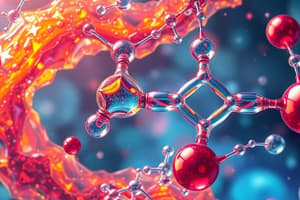Podcast
Questions and Answers
What is the product formed when acetylene undergoes acid-catalyzed hydration?
What is the product formed when acetylene undergoes acid-catalyzed hydration?
- Aldehyde (correct)
- Butan-2-one
- Propan-1-ol
- Vinyl alcohol
Which reagent is commonly used for the acid-catalyzed hydration of alkynes?
Which reagent is commonly used for the acid-catalyzed hydration of alkynes?
- Potassium bromide
- Mercuric sulfate in aqueous sulfuric acid (correct)
- Aluminum chloride
- Sodium acetate
What type of alcohol is formed from the hydration of propyne?
What type of alcohol is formed from the hydration of propyne?
- Vinyl alcohol
- Propen-1-ol (correct)
- Ethanol
- Isopropyl alcohol
During the bromination of alkynes, what is the first product formed?
During the bromination of alkynes, what is the first product formed?
What is produced as a byproduct during ozonolysis of alkynes?
What is produced as a byproduct during ozonolysis of alkynes?
Flashcards are hidden until you start studying
Study Notes
Hydration of Alkynes
- Alkynes undergo acid-catalyzed hydration, adding water across the triple bond.
- Mercuric ion acts as a catalyst, often using mercuric sulfate in aqueous sulfuric acid.
- Hydration resembles that of alkenes and follows Markovnikov's rule, where the more substituted carbon gets the higher electron density.
- Enol formation occurs through tautomerization, leading to the corresponding aldehyde or ketone.
- For terminal alkynes like acetylene, the product is an aldehyde.
- Higher alkynes yield a ketone after hydration.
- Example reactions:
- $H-C\equiv C-H$ (ethyne) + $H-OH$ → Vinyl alcohol ($CH_{2}=CH-OH$).
- $H-C\equiv C-CH_{3}$ (propyne) + $H-OH$ → Propen-1-ol ($CH_{2}=C(OH)-CH_{3}$).
Halogenation (Bromination) of Alkynes
- Bromine reacts with alkynes in a two-step process, first forming dibromoalkene (primarily in trans configuration), followed by formation of tetrabromides.
- Reaction occurs in carbon tetrachloride ($CCl_{4}$):
- $H-C\equiv C-H$ + $Br-Br$ → 1,2-dibromoethene.
- $HC\equiv CH$ + $Br-Br$ → 1,2-dibromoethene.
- Chlorination follows a similar mechanism to bromination.
Ozonolysis of Alkynes
- Alkynes react with ozone, resulting in the formation of ozonides.
- Ozonides can be subsequently treated with water to generate 1,2-dicarbonyl compounds.
- The reaction produces hydrogen peroxide as a byproduct.
Studying That Suits You
Use AI to generate personalized quizzes and flashcards to suit your learning preferences.




